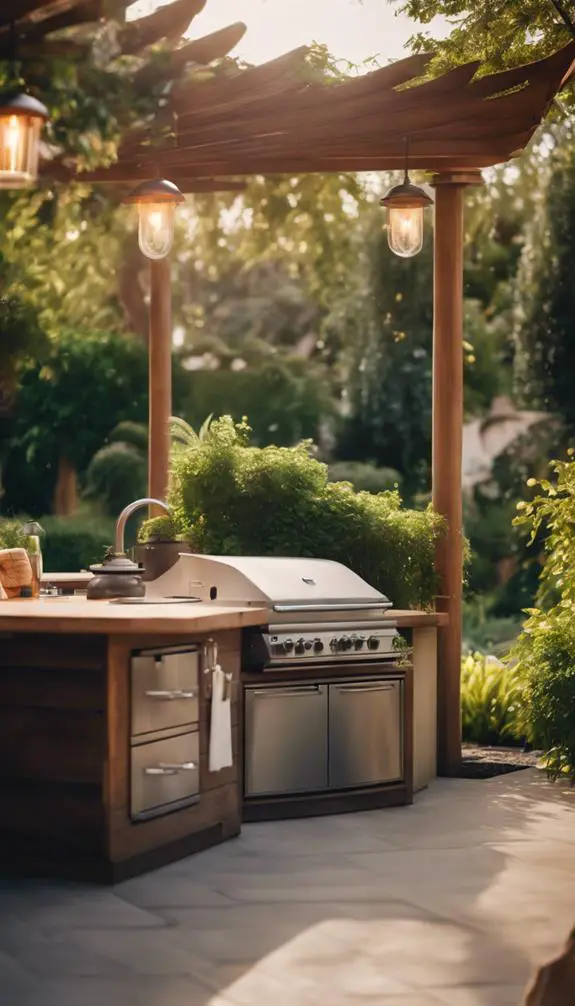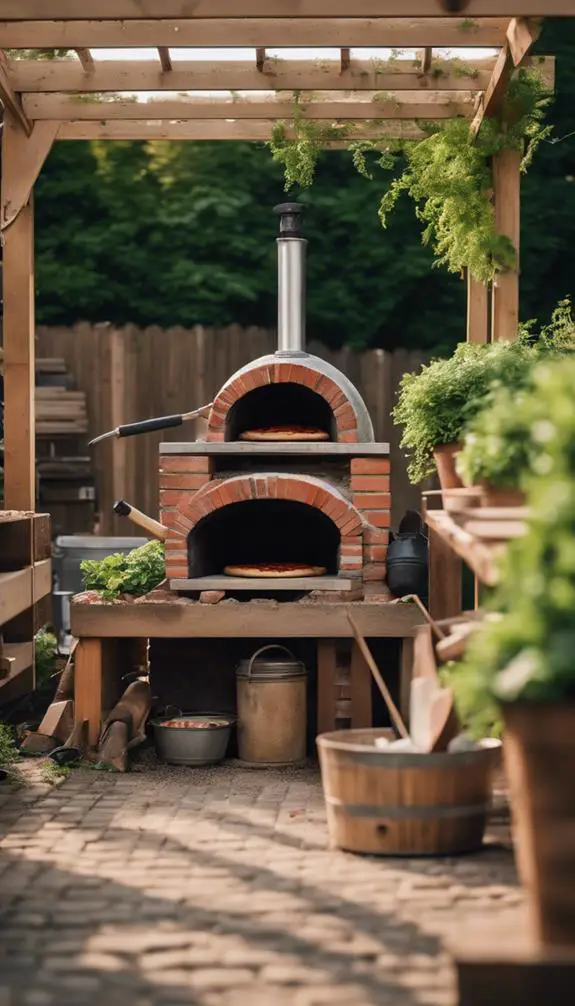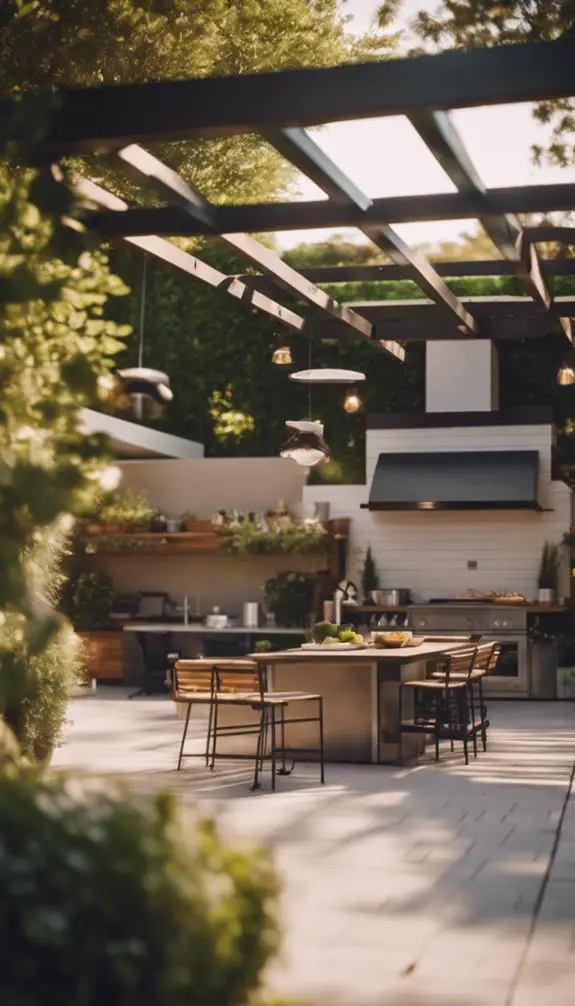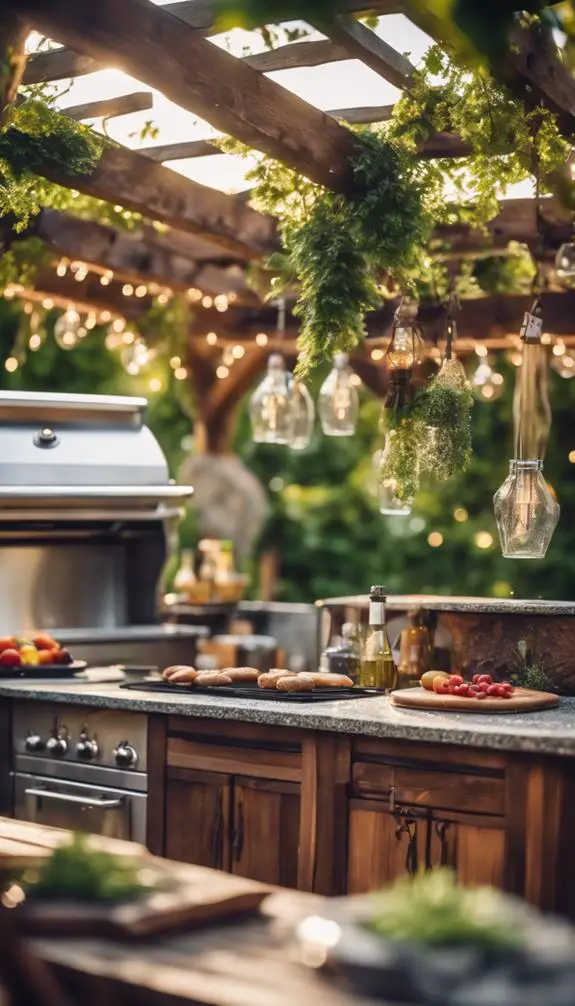As you step into your backyard, you envision a space where you can effortlessly entertain friends and family, savor delicious meals, and create lasting memories. A well-designed backyard kitchen can make this vision a reality. But where do you start? What are the essential components that'll transform your outdoor space into a functional and inviting hub? You're about to discover the secrets to crafting a seamless workflow, selecting the right appliances, and creating a layout that flows effortlessly. The possibilities are endless, and it all begins with understanding the fundamentals of a backyard kitchen.
Summary
- A functional backyard kitchen requires three essential components: a cooking station, food preparation area, and storage space.
- Strategically position these elements to create a seamless workflow, minimizing travel distances and optimizing traffic flow.
- A well-designed cooking station should feature high-performance appliances, such as a grill, cooktop, or pizza oven, protected from direct sunlight and moisture.
- Ambient lighting, seating, and dining areas can create a warm and inviting ambiance, perfect for outdoor entertainment and relaxation.
- Landscaping plays a crucial role in creating an immersive outdoor experience, balancing aesthetics with functionality and incorporating visual interest.
Backyard Kitchen Essentials

Three must-have components form the foundation of a functional backyard kitchen: a cooking station, food preparation area, and storage space.
You'll want to strategically position these elements to create a seamless workflow.
The cooking station should be equipped with high-performance appliances, such as a grill, cooktop, or pizza oven, to cater to your outdoor culinary needs.
The food preparation area should feature a durable, weather-resistant countertop and ample space for chopping, slicing, and dicing.
Storage space is essential for keeping utensils, seasonings, and cookware within easy reach.
Designing for Functionality

You'll want to allocate essential space for each functional zone, considering the "work triangle" concept, where your grill, sink, and refrigerator form the points of a triangular workflow.
Next, you'll design an efficient workflow by positioning each zone to minimize travel distances and optimize traffic flow.
Essential Space Planning
A well-designed backyard kitchen begins with essential space planning, where functionality meets aesthetics.
As you design your outdoor kitchen, allocate space thoughtfully to guarantee a harmonious flow between zones. Create distinct areas for cooking, dining, and socializing to foster a functional and enjoyable experience.
Consider the "work triangle" concept, where your grill, sink, and refrigerator form the points of a triangle to optimize movement and efficiency.
Zone creation is vital, as it dictates the overall layout and usability of your backyard kitchen. By strategically assigning space to each zone, you'll create a smooth shift between cooking, dining, and relaxation areas, ultimately enhancing your outdoor entertainment experience.
Efficient Workflow Design
Beyond the zone creation, a thoughtful workflow design lies at the heart of a functional backyard kitchen.
You'll want to create a seamless flow between zones to maximize efficiency. The classic Kitchen Triangle concept is a great starting point, where the sink, cooktop, and refrigerator form the points of a triangle to reduce walking distances.
To take it further, incorporate workflow hacks like a prep area adjacent to the cooktop, a utensil organizer near the grill, or a built-in trash can beneath the countertops.
Consider the "workstations" approach, where each zone is designed around a specific task, like food prep or cooking.
Choosing the Right Grills

Frequently, homeowners find themselves torn between various grill options, each promising to elevate their backyard kitchen experience.
When choosing the right grill, consider the type of cooking you'll be doing most often. Gas grills provide instant heat and easy temperature control, while charcoal grills offer a rich, smoky flavor. Ceramic infrared grills are perfect for achieving perfect grill marks, and pellet grills provide a convenient, low-maintenance option.
Regardless of your choice, prioritize grill maintenance tips, such as regular cleaning and oiling, to guarantee a lifetime of peak performance. By selecting the right grill for your needs, you'll be well on your way to creating a backyard kitchen that's both functional and impressive.
Outdoor Refrigeration Options

Your backyard kitchen isn't complete without a reliable outdoor refrigeration system to keep your drinks and ingredients fresh.
When selecting outdoor units, consider the size, capacity, and features that fit your needs. You'll want to think about the type of items you'll be storing, the frequency of use, and the climate you're in.
Refrigerator placement is also vital, as you'll need to guarantee it's protected from direct sunlight, moisture, and extreme temperatures. Look for units with weather-resistant materials, UV protection, and advanced cooling technology.
Additionally, consider the aesthetic appeal of the unit, as it will be a visible component of your outdoor kitchen design. By choosing the right outdoor refrigeration system, you'll be able to enjoy fresh food and drinks all season long.
Building a Pizza Oven

Three essential components make up a backyard kitchen: outdoor refrigeration, cooking stations, and a pizza oven.
When building a pizza oven, you'll need to prioritize oven safety. Verify the oven's exterior is at least 3 feet away from any combustible materials.
Next, focus on oven insulation – a vital aspect of retaining heat and cooking efficiency. Use refractory insulation, such as ceramic blankets or vermiculite, to line the oven's dome and walls. This will help maintain temperatures up to 1000°F.
Don't forget to install a chimney or vent to direct smoke and heat away from your outdoor kitchen. With proper planning and execution, your pizza oven will become the centerpiece of your backyard kitchen.
Outdoor Cooking Stations

As you move beyond the pizza oven, your backyard kitchen's cooking stations come into focus.
You'll likely want multiple stations to accommodate different cooking techniques. A grilling station with a built-in gas or charcoal grill is a must-have for any outdoor kitchen.
Consider adding a cooking island with a prep sink, storage, and ample counter space. Don't forget a designated area for food prep, like a butcher block or stainless steel countertop.
To tie it all together, incorporate outdoor decor that complements your cooking stations, such as pendant lighting, outdoor heaters, or a statement piece of art.
With these stations, you'll be able to master various cooking techniques, from grilling and roasting to sautéing and more.
Adding a Wet Bar

When designing your outdoor wet bar, you'll want to ponder the essentials: a durable countertop, ample storage for glasses and bottles, and a sink or ice maker to keep drinks cold and revitalizing.
You'll also need to decide on the style and layout of your bar, whether it's a built-in unit or a freestanding structure.
With the right design, you'll be able to offer a variety of invigorating drink options to your guests, from craft cocktails to cold beers and wine.
Bar Design Essentials
Designing a wet bar for your backyard kitchen requires careful consideration of several essential elements.
You'll want to choose a bar theme that complements your outdoor space, whether it's modern, rustic, or tropical. Unique materials such as reclaimed wood, stainless steel, or glass can add visual interest to your design.
Consider the layout: will it be a straight bar, an L-shape, or a U-shape? Think about the functionality you need, including storage for glasses, bottles, and mixers.
Don't forget to incorporate electrical outlets, lighting, and a sink or ice bin if necessary. By balancing aesthetics and functionality, you'll create a wet bar that's both stylish and efficient.
Refreshing Drink Options
Behind your wet bar, a world of revitalizing drink options awaits.
You'll be the envy of the neighborhood with a menu that showcases Summer Sippers like cucumber-lime refresher and strawberry-basil cooler. Fruit Infusions take center stage, with flavors like peach-ginger and raspberry-mint.
A built-in ice maker and refrigeration unit guarantee your ingredients are always chilled to perfection. Add a few garnishes like mint leaves, citrus wedges, and edible flowers to elevate your creations.
With a built-in sink and ample counter space, you'll have everything you need to craft the perfect drink. Whether you're entertaining a crowd or relaxing solo, your wet bar is the ultimate destination for invigorating drink options.
Ambient Lighting Ideas

As you step into your backyard kitchen, the soft glow of ambient lighting envelops you, setting the tone for a warm and inviting atmosphere.
To achieve this, consider installing string lights or fairy lights around the perimeter of your outdoor space. These delicate fixtures emit a gentle, warm ambiance that's perfect for cozy gatherings.
For a more modern take, try recessed LED lights embedded in the patio or walkways. These subtle fixtures provide a soft glow without visual clutter.
Alternatively, table lamps or floor lanterns can add a touch of sophistication while still maintaining a warm ambiance.
Seating and Dining Areas

With the warm ambiance of your backyard kitchen set, it's time to focus on creating inviting seating and dining areas where you can relax and entertain.
Consider incorporating cozy nooks with plush outdoor furniture, like sectionals or oversized armchairs, to create intimate conversation spaces.
For casual gatherings, opt for a mix of high and low seating, like bar stools and lounge chairs, to encourage socializing.
Define different zones with area rugs, umbrellas, or pergolas to create visual interest and define spaces.
Don't forget to incorporate built-in benches or banquettes to maximize space and create a sense of flow.
Landscaping for a Kitchen

Beyond the kitchen's functional zones, landscaping plays a crucial role in creating an immersive outdoor experience.
You'll want to balance aesthetics with functionality, incorporating elements that enhance the space without obstructing cooking or dining areas. Consider incorporating lawn ornaments, such as sculptures or birdbaths, to add visual interest and create focal points.
Garden paths, made from materials like gravel, brick, or stone, can guide guests through the space while defining different areas. Strategically place plants with varying textures, colors, and bloom times to create a dynamic, ever-changing atmosphere.
Budgeting for Your Dream

Your dream backyard kitchen is taking shape, but now it's time to crunch the numbers and determine how much you're willing to invest in this outdoor oasis.
Create a Dream Board, a visual representation of your desired space, to help you prioritize your must-haves and nice-to-haves.
Next, create a Budget Breakdown, allocating funds to each component, from cooking stations to seating areas.
Consider the cost of materials, labor, and permits, as well as any necessary infrastructure upgrades, like electrical or plumbing installations.
Be realistic about your budget and make adjustments accordingly.
With a clear financial plan in place, you'll be able to bring your dream backyard kitchen to life without breaking the bank.
Maintenance and Upkeep Tips

You'll want to establish a regular cleaning routine to prevent dirt and grime from building up in your backyard kitchen.
Scheduling regular inspections will help you identify potential issues before they become major problems.
Cleanliness Is Key
A well-maintained outdoor kitchen is a reflection of its owner's pride and attention to detail.
You'll want to establish daily routines to keep your space clean and hygienic. After each use, clean and sanitize countertops, grills, and appliances to prevent grease buildup and bacterial growth.
Regularly sweep and mop floors to remove debris and spills. Don't forget to empty trash cans and recycling bins to prevent pest infestations.
Implement a pest control strategy, such as sealing entry points and using natural deterrents, to keep unwanted critters away. By incorporating these habits into your daily routine, you'll guarantee a safe and enjoyable outdoor cooking experience.
Regular Inspections Needed
Beyond daily cleanups, regular inspections are crucial to identify and address potential issues before they become major problems.
You'll want to examine your backyard kitchen's appliances, plumbing, and electrical systems for signs of wear and tear. Look for frayed cords, corroded pipes, and rusted components that could compromise kitchen safety.
Additionally, inspect for pest control issues, such as cockroach droppings, rodent gnaw marks, or termite damage.
Check for proper ventilation, verifying that your kitchen doesn't become a breeding ground for mold and mildew.
Seasonal Deep Cleaning
As the seasons change, your backyard kitchen requires a thorough makeover to maintain its sparkle and functionality.
You'll want to create a Spring Checklist to tackle tasks like power washing the patio, cleaning the grill, and inspecting outdoor lighting.
Come summer, give your space a Summer Refresh by scrubbing outdoor furniture, replacing worn-out cushions, and pruning nearby greenery.
Don't forget to deep clean your outdoor kitchen appliances, including the refrigerator, sink, and countertops.
Take this opportunity to reorganize your storage and restock supplies.
FAQs
Can I Install a Backyard Kitchen in a Small Yard?
You can creatively configure a small yard by optimizing the layout, utilizing vertical space, and selecting compact appliances to fit your needs, ultimately achieving a functional outdoor kitchen despite spatial limitations.
Do I Need a Permit to Build a Backyard Kitchen?
When building an outdoor structure, you'll likely need a permit, which involves complying with local building codes and paying permit fees, so research your area's regulations to certify your project meets requirements and budget.
How Do I Keep Pests Out of My Outdoor Kitchen?
To keep pests out, you'll implement strategic pest control methods, ensuring outdoor cleanliness by sealing entry points, storing food properly, and incorporating pest-repellent landscaping, creating a pest-free haven in your outdoor space.
Can I Use a Gas Grill Indoors During the Winter?
You shouldn't use a gas grill indoors during winter without proper ventilation; instead, invest in a high-powered range hood or exhaust fan to remove carbon monoxide and moisture, ensuring safe and efficient winter grilling.
Are Outdoor Kitchens a Good Investment for Resale Value?
When you invest in an outdoor kitchen, you're not only enhancing your living space but also boosting your property value, potentially yielding a significant return investment that'll make your home stand out in a competitive market.
Conclusion
You've carefully crafted your backyard kitchen, balancing form and function to create an outdoor oasis. Now, envision the sizzle of burgers on your high-performance grill, the chill of drinks in your outdoor refrigerator, and the aroma of freshly baked pizzas from your wood-fired oven. As you finalize your design, remember to budget for the details, plan for maintenance, and get ready to savor the perfect blend of style and functionality in your new outdoor haven.




